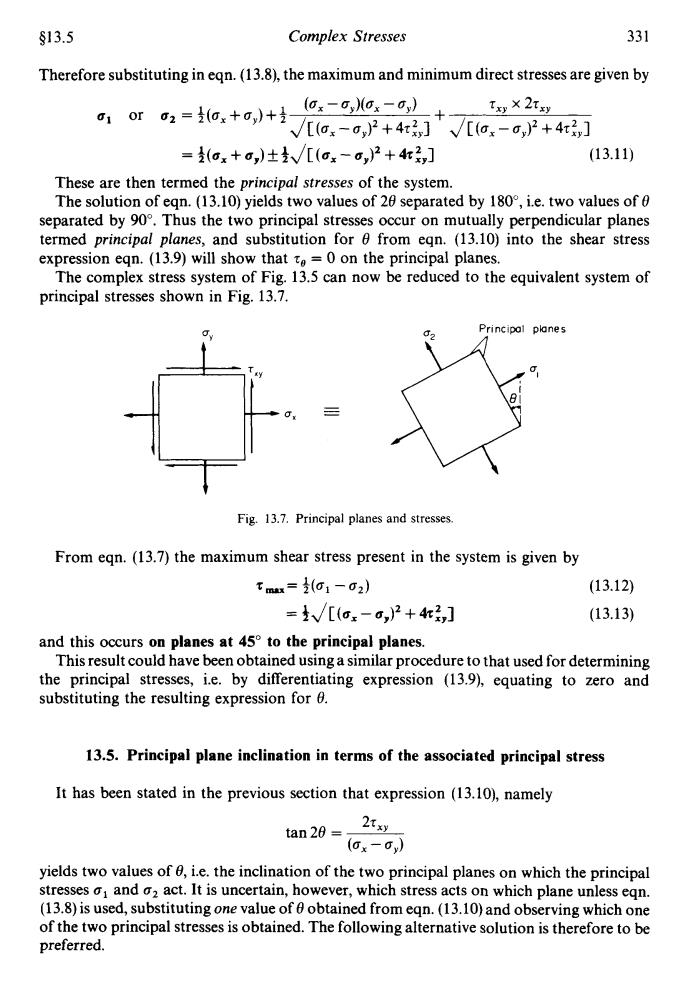正在加载图片...

s13.5 Complex Stresses 331 Therefore substituting in eqn.(13.8),the maximum and minimum direct stresses are given by 10r2=ox+o,)+生亿:-,a:-0,) Txy×2ry √/[(o.-o,)2+4t]'√[(ox-o,)2+4t] =(ox+o,)±√[(ox-o,)2+4t,] (13.11) These are then termed the principal stresses of the system. The solution of eqn.(13.10)yields two values of 20 separated by 180,i.e.two values of separated by 90.Thus the two principal stresses occur on mutually perpendicular planes termed principal planes,and substitution for e from eqn.(13.10)into the shear stress expression eqn.(13.9)will show that to=0 on the principal planes. The complex stress system of Fig.13.5 can now be reduced to the equivalent system of principal stresses shown in Fig.13.7. Principal planes Fig.13.7.Principal planes and stresses. From eqn.(13.7)the maximum shear stress present in the system is given by t=2(o1-02) (13.12) =t√[(ox-o,)2+4,] (13.13) and this occurs on planes at 45 to the principal planes. This result could have been obtained using a similar procedure to that used for determining the principal stresses,i.e.by differentiating expression (13.9),equating to zero and substituting the resulting expression for 6. 13.5.Principal plane inclination in terms of the associated principal stress It has been stated in the previous section that expression (13.10),namely tan 20 2tx (ox-0) yields two values of 0,i.e.the inclination of the two principal planes on which the principal stresses a;and g2 act.It is uncertain,however,which stress acts on which plane unless eqn. (13.8)is used,substituting one value of 6 obtained from eqn.(13.10)and observing which one of the two principal stresses is obtained.The following alternative solution is therefore to be preferred.$1 3.5 Complex Stresses 33 1 Therefore substituting in eqn. (13.Q the maximum and minimum direct stresses are given by These are then termed the principal stresses of the system. The solution of eqn. (13.10) yields two values of 28 separated by 180", i.e. two values of 8 separated by 90". Thus the two principal stresses occur on mutually perpendicular planes termed principal planes, and substitution for 8 from eqn. (13.10) into the shear stress expression eqn. (13.9) will show that z, = 0 on the principal planes. The complex stress system of Fig. 13.5 can now be reduced to the equivalent system of principal stresses shown in Fig. 13.7. Fig. 13.7. Principal planes and stresses. From eqn. (13.7) the maximum shear stress present in the system is given by z,= +@l-oZ) (1 3.12) = &JC(n, - @,I2 + 421y1 ( 1 3.1 3) and this occurs on planes at 45" to the principal planes. This result could have been obtained using a similar procedure to that used for determining the principal stresses, i.e. by differentiating expression (13.9), equating to zero and substituting the resulting expression for 8. 13.5. Principal plane inclination in terms of the associated principal stress It has been stated in the previous section that expression (13.10), namely 25xy (ax - a,) tan 28 = ~ yields two values of 8, i.e. the inclination of the two principal planes on which the principal stresses o1 and a2 act. It is uncertain, however, which stress acts on which plane unless eqn. (13.8) is used, substituting one value of 8 obtained from eqn. (13.10) and observing which one of the two principal stresses is obtained. The following alternative solution is therefore to be preferred